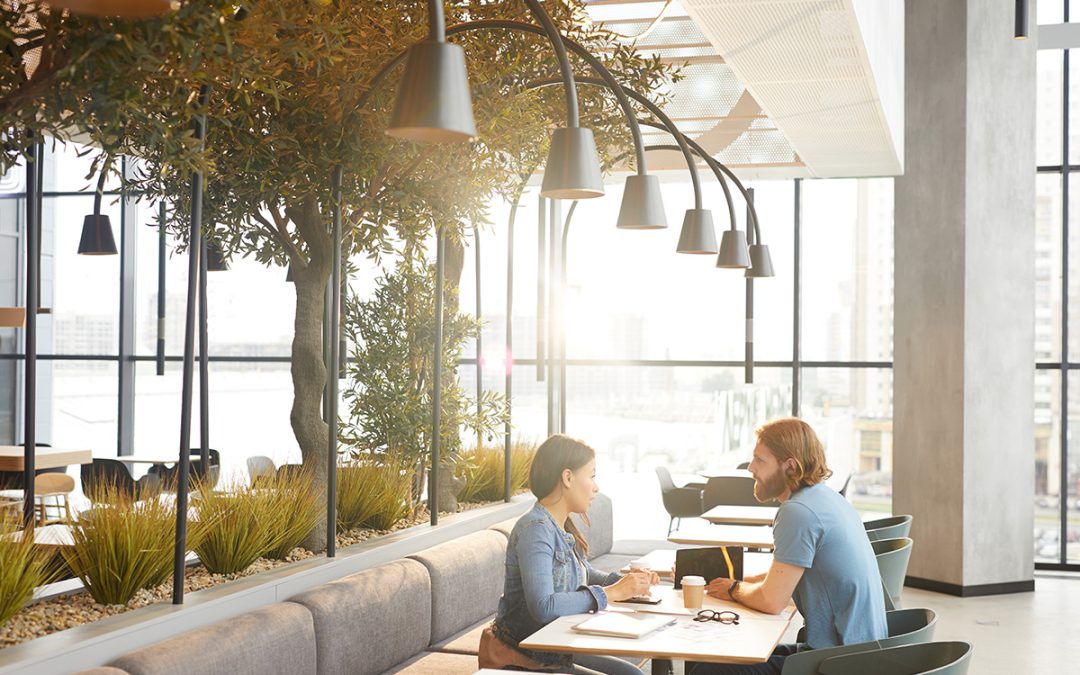Biophilic design, a growing trend in workplace architecture and interior design, is more than just an aesthetic choice. It is a powerful tool for enhancing employee well-being, productivity, and overall job satisfaction. Rooted in the concept of biophilia, which refers to humans’ innate connection to nature, biophilic design integrates natural elements into the built environment to create spaces that support physical, mental, and emotional health.
As workplaces evolve to prioritize employee experience, biophilic design is gaining attention for its transformative impact. From reducing stress to boosting creativity, the benefits of this design approach are profound and far-reaching.
The Key Elements of Biophilic Design
Biophilic design encompasses a wide range of strategies to incorporate natural elements into workplace environments. These strategies can be broadly categorized into three types:
- Direct Connections to Nature: Incorporating living plants, natural light, and water features into the workspace.
- Indirect Connections to Nature: Using materials, patterns, and colors that evoke the natural world, such as wood, stone, and earth tones.
- Spatial Configurations Inspired by Nature: Designing spaces to mimic natural environments, such as open layouts, cozy refuge areas, and dynamic lighting.
By integrating these elements, workplaces can create environments that mimic the restorative effects of being in nature.
The Benefits of Biophilic Design in the Workplace
1. Reduced Stress and Improved Mental Health
Work-related stress is a common issue that affects employee health and productivity. Biophilic design can play a significant role in alleviating stress by creating calming environments. Research shows that exposure to natural elements, such as plants and natural light, reduces cortisol levels, the hormone associated with stress.
For example, employees working in offices with greenery or views of nature report lower levels of anxiety and fatigue. Water features, such as fountains or aquariums, can further enhance relaxation by introducing soothing sounds and visual appeal.
2. Enhanced Productivity and Focus
Biophilic design has been shown to improve cognitive function and focus. Natural light, in particular, is a powerful productivity booster. Studies reveal that employees in well-lit offices are more alert, make fewer errors, and experience less eye strain compared to those working under artificial lighting.
Greenery in the workplace also contributes to better concentration. Plants help regulate humidity, filter toxins, and improve air quality, creating a healthier and more conducive environment for work. Additionally, exposure to natural patterns and textures can reduce mental fatigue and improve problem-solving abilities.
3. Boosted Creativity and Innovation
Creativity thrives in environments that inspire and energize. Biophilic design achieves this by stimulating the senses through natural elements. Colors, textures, and organic shapes reminiscent of the natural world foster a sense of wonder and curiosity, encouraging innovative thinking.
Research has shown that employees working in biophilic environments generate more creative ideas and solutions compared to those in conventional office settings. For industries where innovation is critical, such as technology or marketing, biophilic design can be a game-changer.
4. Improved Physical Health
Biophilic design doesn’t just benefit the mind—it also supports physical health. Natural ventilation and improved air quality from plants reduce the risk of respiratory issues and other health problems associated with poor indoor environments. Natural light exposure helps regulate circadian rhythms, leading to better sleep quality and overall health.
Workspaces designed with biophilic principles also encourage movement and physical activity. For instance, incorporating walking paths, staircases with natural materials, or outdoor work areas motivates employees to stay active throughout the day.
5. Enhanced Employee Engagement and Satisfaction
A thoughtfully designed workspace signals to employees that their well-being is a priority. Biophilic environments are not only visually appealing but also create a sense of connection and purpose. Employees in these spaces often feel more valued and engaged, leading to higher job satisfaction and loyalty.
Workplace satisfaction translates into tangible benefits for businesses, including reduced absenteeism, lower turnover rates, and a more positive workplace culture.
6. Strengthened Team Collaboration
Biophilic design encourages collaboration by creating inviting spaces for teamwork. Open layouts with greenery, natural light, and comfortable seating foster a sense of community and make employees more inclined to interact and share ideas. Outdoor meeting areas or break spaces surrounded by nature can further enhance team bonding and creativity.
Real-World Examples of Biophilic Design in Action
1. Amazon Spheres
Amazon’s headquarters in Seattle features the iconic Spheres, glass structures filled with over 40,000 plants from around the globe. These biophilic spaces provide employees with a relaxing environment to meet, work, and innovate, enhancing their overall workplace experience.
2. Google Offices
Google’s offices worldwide are renowned for incorporating biophilic elements. From rooftop gardens to indoor greenery and abundant natural light, these spaces are designed to boost employee happiness, creativity, and productivity.
3. Etsy Headquarters
Etsy’s Brooklyn headquarters is a prime example of biophilic design in action. The building features green walls, natural materials, and ample daylight, creating a workplace that reflects Etsy’s commitment to sustainability and employee well-being.
How to Incorporate Biophilic Design in Your Workplace
Implementing biophilic design doesn’t have to be an expensive or extensive project. Here are some practical tips to get started:
- Add Indoor Plants: Place potted plants or create a living wall to bring greenery into the office.
- Maximize Natural Light: Rearrange workspaces to take advantage of windows and skylights.
- Use Natural Materials: Incorporate wood, stone, or bamboo in furniture and finishes.
- Introduce Water Features: Add fountains, aquariums, or soundscapes to create a calming atmosphere.
- Create Outdoor Spaces: Set up outdoor seating or gardens where employees can relax and collaborate.
Conclusion
Biophilic design is more than a workplace trend—it is a proven approach to creating environments that support human well-being, creativity, and productivity. By integrating natural elements into the workplace, businesses can unlock the potential of their employees and create spaces where people thrive. As the modern workforce increasingly values health, sustainability, and connection, biophilic design offers a strategic way to attract and retain talent while fostering a culture of innovation and excellence.

